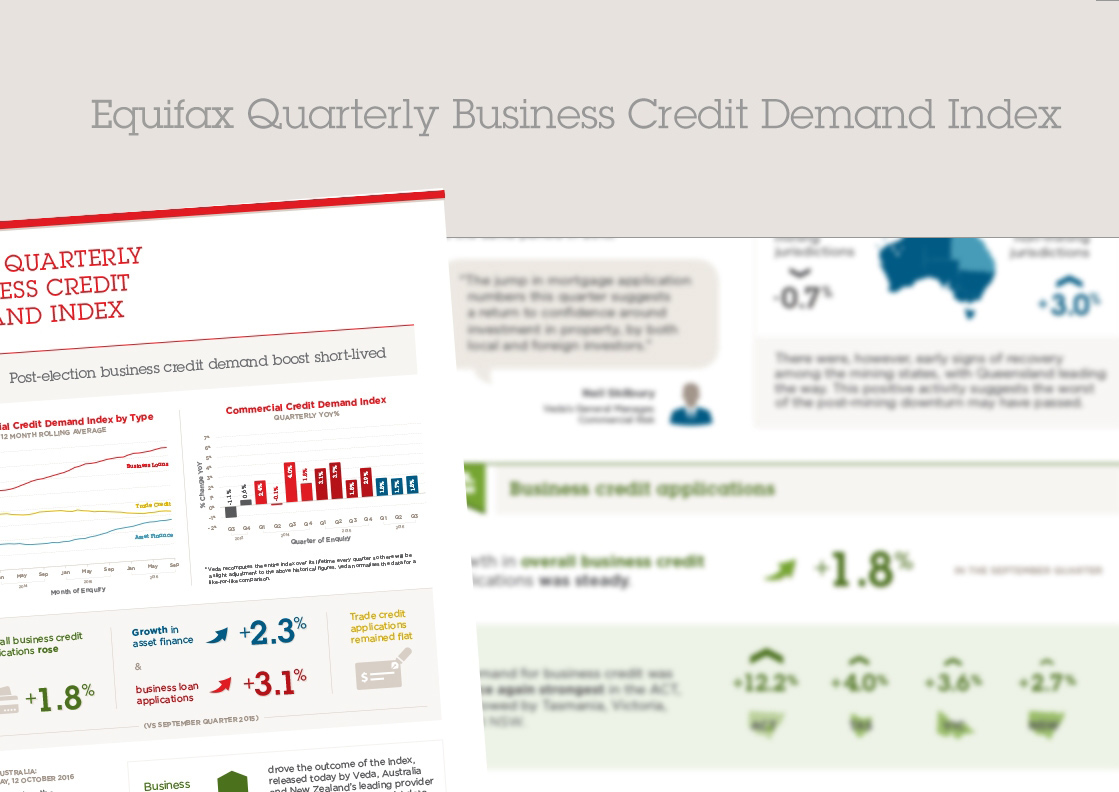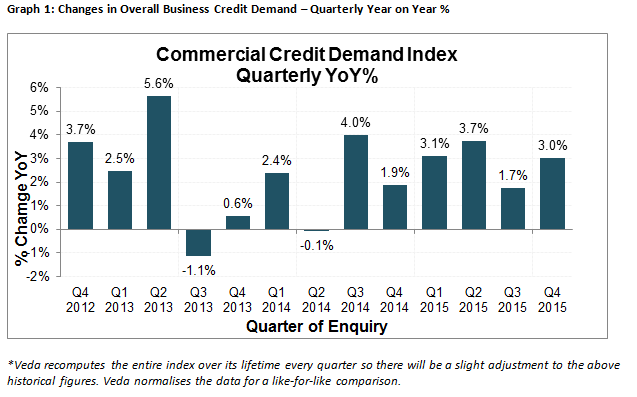Growth continued in business credit for December quarter

Veda Quarterly Business Credit Demand Index: December 2015 Quarter
- Overall business credit applications rose 3.0% (vs December quarter 2014)
- Asset finance and business loan applications improved, but trade credit weakened (vs December quarter 2014)
- Growth in asset finance and business loan applications compensated for ongoing contraction in trade credit
Sydney, Australia: 21 January 2016 – The Veda Quarterly Business Credit Demand Index, measuring applications for business loans, trade credit and asset finance, rose by 3.0% in the December 2015 quarter.
Released today, the Index reveals asset finance applications grew +8.7% in the December quarter, while business loans also rose (+4.1%). Trade credit applications continued to decline (-2.6%) in the December quarter 2015 compared to the same period in 2014.
The Veda Business Credit Demand Index has historically proven to be a lead indicator of how the overall economy is performing. Veda’s data continues to indicate solid growth in credit demand for business, with overall business credit applications increasing from an annual growth rate of 1.7% in the September quarter 2015.
Given the historical relationship between the Veda Business Credit Demand Index and growth in real GDP, Veda’s latest business credit data for the December quarter indicates growth in the Australian economy is slightly stronger than the annual growth rate of 2.5% (Australian Bureau of Statistics) recorded in the September quarter.
Veda’s General Manager, Commercial Risk and New Markets, Paul McFadden said: “The growth in business credit demand in the December quarter is a positive sign, despite recent instability in global equity markets.”
Overall business credit applications increased in the December 2015 quarter (+3.0%). The improved conditions were seen across both mining and non-mining jurisdictions, although non-mining states continued to display stronger demand for business credit. The ACT (+9.4%) and NSW (+7.1%) were the states that saw the strongest growth in the December quarter, followed by Victoria (+3.2%), SA (+1.5%) and WA (+0.1%). Queensland (-0.5%) saw a moderate decline in demand, while NT (-20.0%) and Tasmania (-3.6%) both experienced significant weakening of business credit demand.
Business loan applications picked up in the December quarter (+4.1%), reflecting an improvement across all states. In the non-mining states, NSW (+9.6%), the ACT (+6.5%) and Victoria (+4.4%) all experienced growth in applications, while SA (-3.4%) and Tasmania (-3.0%) both saw declines. Amongst the mining states, Queensland (+1.7%) returned to positive growth in business loan applications; however, WA (-2.0%) and the NT (-23.7%) once again recorded falls.
Within business loans, growth in lending proposals (+8.1%) picked up in the December quarter, as did credit cards (+14.2%). Mortgage applications (+6.6%) eased for the second consecutive quarter after a period of strong growth earlier in 2015.
Trade credit applications fell again in the December quarter (-2.6%). Trade credit applications recorded a fall over the past 12 months in NSW (-0.2%), SA (-0.2%), WA (-0.5%), Victoria (-2.3%), Tasmania (-6.8%), Queensland (-7.3%), and the NT (-22.1%), with the ACT (+8.6%) the only jurisdiction recording a rise.
The softening of growth of trade credit applications was largely driven by weakness in the main category of 30-day accounts (-4.0%), with applications for 7-day accounts (-7.7%) also weakening.
Asset finance applications grew in the December quarter (+8.7%). The increase represented an improvement in the annual rate of growth for asset finance applications from 6.9% in the September quarter.
The ACT (+15.0%), NSW (+12.3%), SA (+12.1%), and Victoria (+7.6%) experienced particularly strong growth in asset finance applications, followed by Queensland (+5.9%), WA (+4.6%), and Tasmania (+0.2%). The NT (-6.3%) was the only jurisdiction that still recorded a fall over the past year. The December quarter saw the mining jurisdictions returning to positive growth for the first time after a sustained fall since 2013.
The strength in asset finance in the December quarter was led by personal loans (+12.7%), with leasing applications (+7.9%) also picking up. Applications for hire purchase (+10.4%) eased in the December quarter but remained strong.
The strong performance of asset finance for the second consecutive quarter suggests that the Federal Government’s budget incentives for business have gained traction, and are having a positive impact on business credit demand.
“Asset finance and business loans have both grown and are traditionally used for business investment, while trade credit, which continued to decline this quarter, is often used to cover current trading and cash flow management.
“Growth in business loans and asset finance also suggests the value of credit being applied for is increasing. The volume and value of business loans (typically $100,000 - $200,000) and asset finance applications (typically $40,000 - $60,000) more than compensates for the contraction in trade credit applications (typically $5,000 - $10,000),” Mr McFadden added.

NOTE TO EDITORS
The Veda Quarterly Business Credit Demand Index measures the volume of credit applications that go through the Veda Commercial Bureau by credit providers such as financial institutions and major corporations in Australia. Based on this it is a good measure of intentions to acquire credit by businesses. This differs to other market measures published by the RBA/ABS, which measure new and cumulative dollar amounts that are actually approved by financial institutions.
DISCLAIMER
Purpose of Veda media releases:
Veda Indices releases are intended as a contemporary contribution to data and commentary in relation to credit activity in the Australian economy. The information in this release is general in nature, is not intended to provide guidance or commentary as to Veda’s financial position and does not constitute legal, accounting or other financial advice. To the extent permitted by law, Veda provides no representations, undertakings or warranties concerning the accuracy, completeness or up-to-date nature of the information provided, and specifically excludes all liability or responsibility for any loss or damage arising out of reliance on information in this release including any consequential or indirect loss, loss of profit, loss of revenue or loss of business opportunity.
